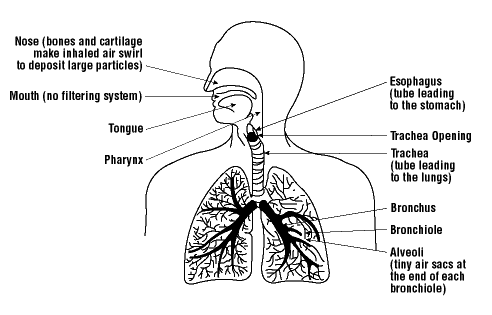How Do Particulates Enter the Respiratory System?
What are particulates?
Particulate matter is the name given to solids or liquids that are distributed in a gas. In the workplace, most often the term "particulates" refers to particles, dust, mist or fume that has become suspended in the surrounding air. The hazard with airborne particulates is that a person may breathe in the chemical that, may have ill effects on an individual's health.What are the parts of the respiratory system that can be affected?
The diagram below shows the parts of the respiratory system. It can divided in two systems - the upper airway passages and the lower airway passages. The upper airway passages includes the nose, nasal passages, mouth and the pharynx down to the vocal cords in the larynx (voice box or "Adam's apple"). The lower airway passages start at the vocal cords, extend down the trachea (windpipe) and continue all the way down to the small air sacs, (alveoli) at the end of every branch of the bronchial tree. The bronchial tree includes the trachea, the bronchus (branches of the trachea going to each lobe of the lung), and bronchioles (branches of the bronchi).
How are particulates deposited in the lungs?
Inhalation is the most important route of exposure in the workplace. When particles are in the air, there is the chance that you will inhale them. How far the particle gets in the air passages of the respiratory system, and what it does when it is deposited, depends on the size, shape, and density of the particulate material. The "what happens" also depends on the chemical and toxic properties of the material.Particles are deposited in the lungs by one of four different ways: interception, impaction, sedimentation, and diffusion.
Interception: A particle is intercepted or deposited when it travels so close to a surface of the airway passages that an edge of the particle touches the surface. This method of deposition is most important for fibres such as asbestos. The fibre length determines where the particle will be intercepted. For example: fibres with a diameter of 1 micrometre (µm) and a length of 200 µm would be deposited in the bronchial tree.
Impaction: When particles are suspended in air, they have a tendency to travel along their original path. When there is a bend in the airway system, for example, many particles do not turn with the air but rather impact or stick to a surface in the particles' original path. The likelihood of impaction depends on the air velocity and the particle mass. Typically, most particles greater than 10 µm (aerodynamic diameter) are deposited in the nose or throat and cannot penetrate the lower tissues of the respiratory tract. Aerodynamic diameter is the diameter of a spherical particle that has the same settling velocity as another particle regardless of its shape, size or density. Using aerodynamic diameters allows occupational hygiene specialists to compare particles of different sizes, shapes and densities in terms of how they will settle out of the air flow stream.
Sedimentation: As particles travel through air, gravitational forces and air resistance eventually overcome their buoyancy (the tendency for the particle to stay up). The result is that the particles will settle on a surface of the lung. This type of deposition is most common in the bronchi, and the bronchioles. Sedimentation is not an important factor when the aerodynamic diameter of the particle is less than 0.5 µm.
Diffusion: The random motion of particles is similar to gas molecules in the air when particles are smaller that 0.5 µm. When particles are in random motion, they deposit on the lung walls mostly by chance. This movement is also know as the "Brownian motion". The smaller the particle size, the more vigorous the movement is. Diffusion is the most important mechanism for deposition in the small airways and alveoli. Very fine particles 001 µm or smaller are also trapped in the upper airway.
What are the factors influencing where particulates are deposited?
In general, particles having an aerodynamic diameter of greater than 10 µm are deposited in the nasopharyngeal region (upper airway passages - nose, nasal cavity and throat) largely by impaction. This mechanism is prominent because of the high air speed and the many turns in the nasopharyngeal air way. The changes in airflow direction cause many particles to hit the walls of the air passage and so the particles deposit or settle in this region.Smaller particles with an aerodynamic diameter of about 0.003 to 5 µm are deposited in the tracheobronchial and alveolar regions. Sedimentation is the most common method because at this point the air has slowed enough for particles to "settle" out.
When the air gets to the alveolar region (the lower lung area), it has slowed even more. The air is essentially calm. Particulates that make it this far into the lungs are usually 0.5 µm or smaller.
They enter the lung essentially by randomly landing on the membrane or other parts of the lung.
Because different sized particles deposit in different areas of the lung, nose or throat, the American Conference of Governmental Industrial Hygienists (ACGIH) is recommending that the concept of particle size-selective limits be incorporated in their occupational exposure limits, the Threshold Limit Values (TLVs). The ACGIH uses the terms inhalable, thoracic, and respirable particulate mass for TLVs for particulates that are hazardous when inhaled.
- Inhalable Particulate Mass-TLVs are for materials that are hazardous when deposited anywhere in the respiratory tract.
- Thoracic Particulate Mass-TLVs are assigned to materials that are hazardous when deposited anywhere within the lung airways and the gas-exchange region (the lower airways passages).
- Respirable Particulate Mass-TLVs are for particulates that are small enough to reach the gas exchange region and are hazardous only if they are deposited in that region.
No comments:
Post a Comment